The only way to save your tomatoes from fungal tomato disease is to prevent it from happening.
Unlike pests, there would be a slim chance to save your tomatoes if you see signs of fungi.
However, using fungicides during the early stage of the fungal disease in tomatoes can stop the fungi from spreading.
Searching for fungicides online is overwhelming, so we listed out the top 10 of the best fungicides for tomatoes that can either prevent, cure, or serve a dual purpose(insecticide) for your tomato plants.
We’ll also provide the good features, limitations, and the active ingredient of each product.
(You could use the table of contents below to jump to the sections that are most important to you.)
The 10 Best Fungicides For Tomatoes – At A Glance
Pictures | Items | Best For | Check Price |
Bonide Mancozeb Fungicide Concentrate | Best for Tomato leaf spot | ||
Southern Ag Liquid Copper Fungicide | Best for early Tomato blight and late Tomato blight | ||
Bonide Copper Fungicide RTU | Best for early Tomato blight | ||
Garden Safe Fungicide Ready-To-Use | Best for Tomato powdery mildew | ||
Spectracide Immunox Fungicide Spray Concentrate | Best for downy mildew | ||
Neem Bliss Neem Oil Fungicide | Best for powdery mildew | ||
Daconil Fungicide Concentrate | Best for septoria leaf spot | ||
Serenade Garden Fungicide | Best for fusarium wilt and verticillium wilt | ||
Mycostop WP Biofungicide 2 Gram | Best for fusarium wilt | ||
Dr. Earth 8007 Ready to Use Disease Control Fungicide | Best for downy mildew |
Common Tomato Fungal Disease
Before we proceed to the top 10 fungicides that you can try for your tomatoes, you must first identify what type of fungi you’re going to deal with.
Here are the common fungal disease on tomatoes:
Tomato Early Blight
Tomato Late Blight
Buckeye Rot
Septoria Leaf Spot
Anthracnose Fruit Rot
10 Best Fungicides For Tomatoes – Reviews
Fungicides come in both concentrate and ready to use or RTU solution.
Make sure to check the label and follow the directions to avoid burning your tomato plants with too much fungicide.
Now, without further ado, here are the gardener’s favorite fungicides for tomatoes:
1. Bonide Mancozeb Fungicide Concentrate
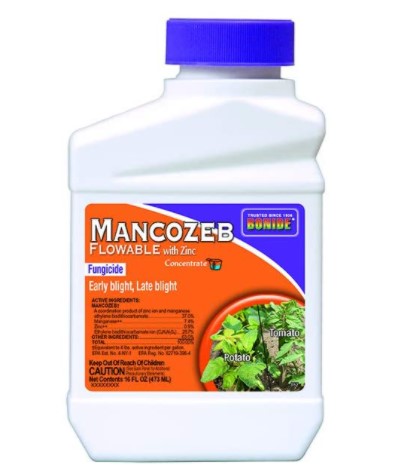
- Best for tomato leaf spot
- Can also be used for the following plants: Potatoes, onions, cucumbers, melons, grapes, geraniums, apples, azaleas, and roses.
- Active ingredient: Mancozeb(contact fungicide) and Zinc
- Treatment for the following fungal diseases: Downy mildew, early tomato blight, late tomato blight, rust on tomato leaves, and botrytis.
- Pros: It is an effective fungicide for a wide range of fungal diseases in tomatoes. Suitable for integrated pest management (IPM). It contains zinc that’s responsible for activating the enzymes that help synthesize plant proteins and promote the healthy growth of plants.
- Cons: The product doesn’t come with specific instructions for proper dilution. However, you can email them about the proper amount of contrate that you need for your tomatoes. The lack of dilution instruction confuses some gardeners on how to use it.
- How to use: This product is best used with a tank sprayer. According to the company, you need 3 tsp. of this fungicide for every gallon of water.
Editor’s note: Mancozeb was declared safe for use by the World Health Organization due to its low-risk toxicity.
2. Southern Ag Liquid Copper Fungicide
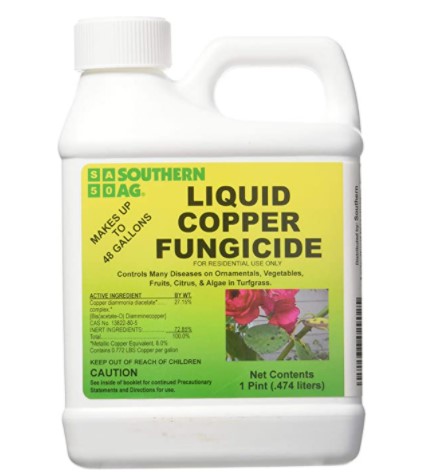
- Best for early tomato blight and late tomato blight
- Can also be used for the following plants: Cucumbers, melons, ornamental plants, and citrus plants.
- Active ingredient: Copper ammonium complex
- Treatment for the following fungal diseases: Downy mildew, septoria, rust, blight leaf spot, and wild black spot.
- Pros: The extra 0.772 of copper in this product increases the antimicrobial properties of this fungicide. Controls not only fungi and bacteria but also moss and algae. Copper sulfate in adequate amounts is not toxic to humans. The product can also help repel snails and slugs.
- Cons: The product is not too effective on fungal infections in the roots of the plant since it is not thoroughly absorbed by the plant. It can be toxic to animals but proper after-use and handling will do the trick.
- How to use: According to the manufacturer, you only need 2 to 6 tsp. of this fungicide per gallon of water for ornamental plants and vegetables. You may check the label on the product for more information. Make sure to wear protective masks and gloves.
3. Bonide Copper Fungicide RTU
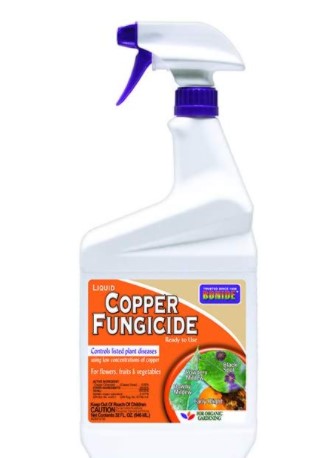
- Best for early tomato blight
- Can also be used for the following plants: Roses, fruits, nuts, herbs, vegetables, turf, and ornamentals.
- Active ingredient: Copper sulfate and copper octanoate or copper soap(copper salt+fatty acid)
- Treatment for the following fungal diseases: late tomato blight, leaf spots, anthracnose, black spot, peach leaf curl, rust and, downy mildew
- Pros: It’s in a ready-to-use formula which is perfect for those who are busy and don’t have much time on their hands. The packaging is already in a spray bottle so you’ll just need to spray it on your plants. The formulation does not burn plants. This product can also help control insects like whiteflies. Helps cure tomato plants that are in the early stages of fungal disease.
- Cons: The product is not too effective on fungal infections in the roots of the plant since it is not thoroughly absorbed by the plant. It can be toxic to animals but proper after-use and handling will do the trick. Rain can wash off this product so you have to re-apply it again. It also may not be able to cure your tomatoes if the fungi disease has already spread to most parts of the plant.
- How to use: It is recommended to use this product as soon as your tomatoes reach 3 feet tall and spray your plants weekly.
4. Garden Safe Fungicide Ready-To-Use
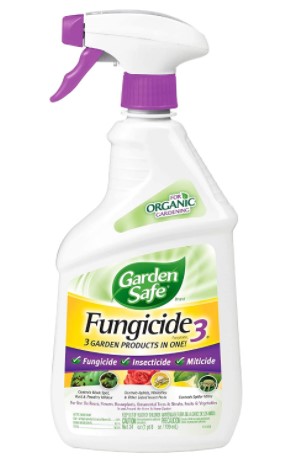
- Best for tomato powdery mildew
- Can also be used for the following plants: Roses, fruits, nuts, herbs, shrubs, vegetables, turf, and ornamentals.
- Active ingredient: Copper sulfate and copper octanoate or copper soap(copper salt+fatty acid)
- Treatment for the following fungal diseases and infestations: Tomato black spot, anthracnose, early blight, and late blight. Also for insects like aphids, scales, caterpillars, beetles, whiteflies, and spider mites.
- Pros: This is an organic product that both works as an insecticide, miticide, and fungicide since it contains neem oil extract. It also comes in a spray bottle and in a ready-to-use formula that’s perfect for busy gardeners out there. Unlike most fungicides, it doesn’t have a very foul smell. You can use this until you harvest your tomatoes. It’s also OMRI listed.
- Cons: Sadly, this fungicide can damage furniture so make sure to avoid spraying it ver your indoor fixtures. It is also highly toxic to bees and should be applied at night or dawn. Even though this fungicide works well with what it claims to treat, some gardeners compare it with pure neem oil fungicide which is cheaper.
- How to use: Apply once or twice a week until tomato fungus is eliminated.
5. Spectracide Immunox Fungicide Spray Concentrate
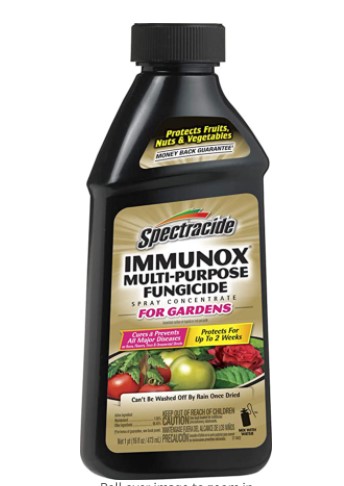
- Best for downy mildew
- Can also be used for the following plants: Roses, fruits, nuts, herbs, shrubs, vegetables, turf, and ornamentals.
- Active ingredient: Myclobutanil triazole
- Treatment for the following fungal diseases: Tomato black spot, brown patch, early blight, and late blight.
- Pros: It can prevent and cure the early stages of fungal infection in plants. It doesn’t wash off after the rain and protects the plants for up to two weeks.
- Cons: This is not an organic fungicide due to its myclobutanil content. It is also not recommended for tomatoes that are soon to be harvested.
- How to use: Wear proper protective equipment like gloves and mask when using on plants. Mix with water as direct in the product label.
6. Neem Bliss Neem Oil Fungicide
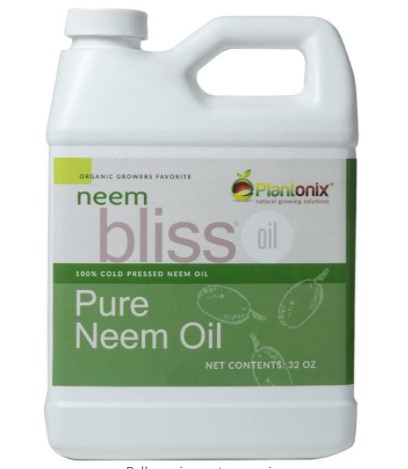
- Best for powdery mildew
- Can also be used for the following plants: Roses, fruits, nuts, herbs, shrubs, vegetables, turf, and ornamentals.
- Active ingredient: Azadirachtin
- Treatment for the following fungal diseases: Black tomato spot, tomato early blight late blight, scab, and rust
- Pros: Neem oil is a natural pesticide and fungicide and can be the best option for organic gardeners. You can use it even up to the day of harvest since it has very low toxicity.
- Cons: It has a very strong garlicky odor.
- How to use: Do not apply directly to your skin. Mix 2 tbsp. of neem oil per 1 gallon of water and 1/2 tsp of mild liquid dish soap as an emulsifier. Shake well. Spray solution generously on all leaf surfaces. Use once or twice a month. Do not apply the solution in direct sunlight to avoid burning the plants. Do a patch test first on some leaves to know the sensitivity of the plant.
7. Daconil Fungicide Concentrate
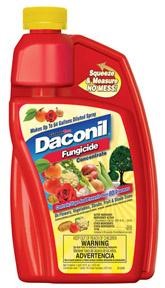
- Best for septoria leaf spot
- Can also be used for the following plants: Fruits, vegetables, flowers, and shade trees.
- Active ingredient: Chlorothalonil
- Treatment for the following fungal diseases: Fungal diseases like early blight, late blight, powdery mildew, grey leaf spot, black mold, botrytis, grey leaf mold, anthracnose, algae, and rust.
- Pros: It can control and prevent a wide variety of plant diseases. It’s also a non-systematic fungicide.
- Cons: This is not an organic fungicide but it’s safe for use. It can also be washed off by rain so you’ll need to re-apply after heavy rain. It’s not recommended to use on home lawns, turf sites, wilted plants, animals, or in areas in people.
- How to use: Wear proper protective equipment like, long-sleeved shirt, gloves and mask when using this product on plants. Mix or dilute the concentrate in a hand-held, hose-end, or tank-type sprayer. Apply the solution thoroughly on plant surfaces and when it’s not windy. Do not spray the solution in your tomato plants during hot weather.
8. Serenade Garden Fungicide
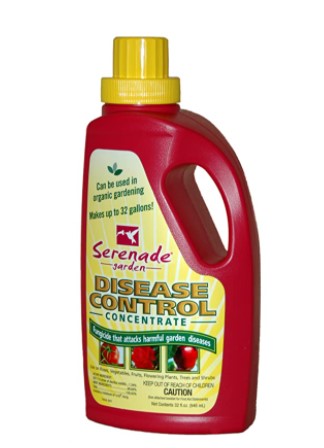
- Best for fusarium wilt and verticillium wilt.
- Can also be used for the following plants: Roses flowers, fruits, medicinal herbs, vegetables, and ornamentals.
- Active ingredient: Bacillus subtilis
- Treatment for the following fungal diseases and infestations: Tomato black spot, brown patch, early blight, soil-dwelling fungus, and late blight.
- Pros: It’s a biological fungicide that’s another best option for organic farmers. It’s also OMRI listed. You can use this fungicide up until you harvest your tomatoes and them the same day they’re treated. The application is also easier than other fungicides because it has no temperature or timing restrictions. It kills the pathogens in fungus without harming good insects and animals.
- Cons: It has a smell that some gardeners don’t like about this product. However, that doesn’t affect the performance of the fungicide.
- How to use: Follow the directions for use in the label. Use a hand-held or hose-attached sprayer to apply the solution on tomato plants.
9. Mycostop WP Biofungicide 2 Gram
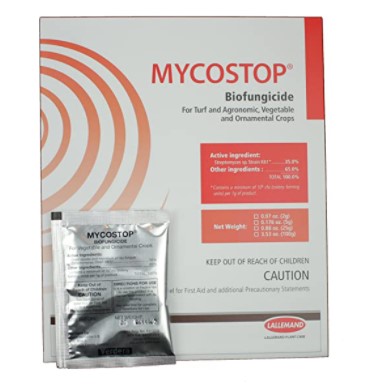
- Best for fusarium wilt
- Can also be used for the following plants: Roses, fruits, nuts, herbs, shrubs, vegetables, turf, and ornamentals.
- Active ingredient: Streptomyces sp. Strain K61
- Treatment for the following fungal diseases: Pathogenic fungi, including Pythium, Fusarium, Alternaria, and Botrytis that cause root rot and wilt
- Pros: It’s OMRI listed which means it’s organic and safe to apply to plants.
- Cons: It can be hard to transfer the powder to the spray bottle without a bit of spill. Make sure you’re wearing protective equipment to keep the fungicide away from your skin.
- How to use: Apply as a soil drench, spray, or pumps. Here’s a video on how to mix the product with water.
10. Dr. Earth 8007 Ready to Use Disease Control Fungicide
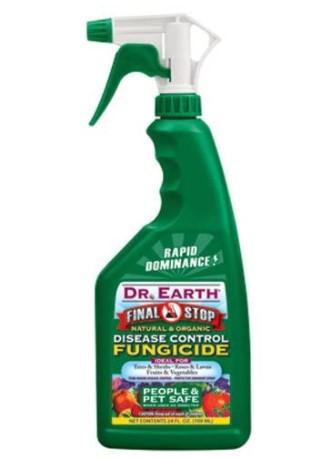
- Best for downy mildew
- Can also be used for the following plants: Vegetables, fruit trees, roses, turf, ornamentals, trees, and shrubs
- Active ingredients: Rosemary and clove oil, cloves, peppermint oil, and malic acid
- Treatment for the following fungal diseases and infestations: Powdery mildew, rust, black spot, peach leaf curl, shot hole, leaf blotch, scab, dollar spot, brown rot, and other plant diseases
- Pros: It’s 100% organic and can be used on indoor plants. It is also not harmful to insects due to their natural ingredients.
- Cons: The spray bottle may diffuse the fungicide properly. You may transfer the contents in your preferred garden spray.
- How to use: Spray the product on your tomatoes at night or dawn. Follow directions on the product label accordingly.
Best DIY Tomato Fungicides
If you have the time to mix some antifungal concoction for your tomatoes here are some of the homemade fungicides that you can try:
Baking Soda Solution:
Mix 1 gallon of water, 1 tbsp. of baking soda, 1 tsp. Vegetable oil and a few drops of dish soap.
Compost Tea
- Mix 1 part aged-compost with 5 to 8 parts of water in a covered container.
- Store it in a room with a temperature of 15 degrees Celsius to 21 degrees Celsius.
- Let it sit for 5 days and you must stir it every day.
- After 5 days you may spray it on your tomatoes two to three weeks before you harvest them.
What You Need To Know About Tomato Fungi and Fungicides
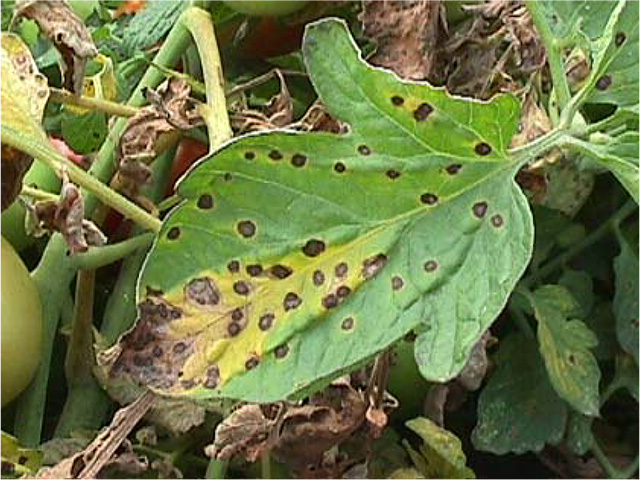
Fungal diseases in tomatoes start without any signs. When signs of fungus show up, it’s probably too late for your plant.
Fungi and bacteria can stay in the soil even winter passes and their pathogens spread through water splashes on leaves and stems.
Certain weather conditions and improper planting practices give the fungi a perfect condition to attack your tomatoes.
So, it’s recommended to anticipate that the fungus is just around the corner waiting to attack your plants. Prevention is key to a fungi-free tomato.
Using fungicides ahead of time can give you peace of mind knowing that you’ve protected your tomatoes even when fungi attempts to attack them.
Most fungicides are also designed for prevention rather than a treatment for heavily infected plants.
Here are some helpful tips about tomato fungi to help you prevent the spread or treat your plants with a fungicide as soon as possible:
1. Septoria Leaf Spot Spreads Fast During Rainy Weather
If your tomatoes are in the early stage of fungal disease, stop the spread of the disease by removing the infected leaves, stem, and fruit. Then apply fungicide all over the plant.
2. The Fungal Disease Signs That You Should Look Out For
- Anthracnose fungal disease will ripen your tomatoes and form circular soaked spots that have a light center with edges that turn black over time.
- Buckeye rot loves targetting green tomatoes and shows signs like brown lesions.
- Early blight shows as target-like spots.
- Late blight shows as gray patches on leaves and stems with brown lesions on the fruit. It usually attacks during the end of the growing season when nights become colder.
3. The Types of Fungicides
Here’s a brief background about the types of fungicides in the market so you can make an educated decision on what product to choose:
- Organic, copper and biological fungicides contain copper, neem oil, and Bacillus subtilis. These active ingredients are derived from organic matter and beneficial bacteria that help fight the fungi or bacteria in plants.
- Chemical fungicides contain myclobutanil and chlorothalonil that are moderately toxic to humans but lethal to insects especially the beneficial ones like bees. Safety measures are advised when using fungicides with this active ingredient.
Pro-Tip: In choosing the best fungicides for tomatoes, you may opt for the organic or eco-friendly brands to help prevent fungal diseases in your tomato plants.
If the natural fungicides don’t work for your tomatoes, you can always try the chemical variants but proceed with caution. Strictly follow the labels and when in doubt, you can always contact the manufacturer for details.
Tips in Applying Fungicide in Tomatoes and How To Keep Fungus at Bay
Taking care of plants is almost the same as taking care of your loved ones.
The only difference is we have complicated emotions compared to plants. From planting tomatoes up to its growing season, you have to monitor, protect, and give the nutrients and water they need so they‘ll reward you with a bountiful harvest.
To learn how to give your tomatoes the TLC that they need and how you can protect them against insects and fungicides, check these helpful tips below:
- Cut out leaves that lay low on the ground since most bacteria come from the soil.
- Water your tomatoes without splashing the leaves to avoid spreading the pathogens of fungi and bacteria. Wet foliage invites fungal disease in plants.
- Check the formulation of copper fungicides because too much copper sulfate can damage your plants.
- Some tomatoes are also sensitive to copper so make sure to do a patch test on some leaves and observe it for a day.
- Follow the instruction on the fungicide label since it comes in different variants like powder, concentrate, and ready-to-use solutions.
- Organic or not, make it a habit to wear a protective mask, gloves, and long sleeves when handling fungicides, insecticides, and miticides. IN stuff like this, it’s better to be safe than sorry.
- Designate a specific bottle for fungicide and don’t use it for other purposes to avoid confusing it with another household solution like bleach or other chemicals.
- Follow the proper planting practices to keep bacteria and fungi from thriving in the soil where your tomatoes are planted.
These practices include:
- Plant tomatoes 15 to 18 inches apart to promote healthy air circulation and plenty of space for them to grow.
- Plant your tomatoes in an area where they can get full sun. They need 6- 8 hours of full sun every day.
- Don’t overfertilize your tomatoes. They only need a cup or less of fertilizer every season.
- Do a plant rotation and transfer your tomatoes every three years.
Frequently Asked Questions
What is the best time of the day to apply fungicide on tomatoes?
Like applying insecticides, apply fungicides at night or early in the morning when the sun is still not up in the sky.
During the day healthy insects roam around your garden and they can die from the fungicide that you’re using. Thus, making an imbalance in the ecosystem in your garden.
Can you stop tomato blight?
If you managed tomato blight in its early stages, you still have a chance to stop it. You need to remove all the infected areas like yellow leaves and other infected parts. Then apply a generous amount of fungicide to your tomatoes.
Can you eat tomatoes sprayed with copper fungicide?
Yes, you can eat them since copper fungicides can be applied until the day you harvest the tomatoes. You can wash it with water or if you’re in doubt use a water-vinegar solution to wash the tomatoes for a more thorough cleaning.
Does tomato blight stay in the soil?
Yes, blight fungi can overwinter in the soil for 3 to 4 years. To remove the blight disease from your soil, you can plant disease-resistant plants or add beneficial fungi to the soil to help you destroy blight.
How often can I spray copper fungicide?
Most fungicides and insecticides are applied every week or twice a month. Avoid applying too much fungicide because it will also damage your plants.
Is copper fungicide toxic to humans?
Copper fungicides contain copper sulfate. Copper sulfate is not found to be toxic to humans and any inhaled or consumed copper by the human body will be eliminated through feces. The USEPA also found no hard evidence that it can cause cancer.
Is vinegar a fungicide?
Yes. Dilute a tablespoon of vinegar to a gallon of water. It may kill the bacteria but the vinegar might damage the foliage. You may try other DIY fungicides like the baking soda solution above.
Can fungicide make you sick?
No, but fungicides can irritate your eyes, skin, throat, and nose.
How much should I water my tomatoes?
Young tomatoes need moist soil during their growing period. So, you should water them daily in the morning. An inch or two of water would be enough for the tomatoes every week.
As they grow, you don’t have to water them as frequently especially when they become established and healthy. They can even go from 3 to 7 days without water given that they are placed in a shady part of your home.
How would I know if I overwatered my tomatoes?
The leaves will start to wither and turn yellow to brown, the roots start to rot and there will be blisters in some leaves.
Final Thoughts
Did you find the best fungicides for tomatoes from the list above?
If you do, then we hope your tomatoes will survive the season and give you a bountiful harvest. We hope this post has helped you learn how to deal with tomato fungi using fungicides.
We aim to give as much information about tomatoes so you can make an educated decision and destroy the fungus in your garden on the first try. We also recommend that you keep yourself safe from the fungicides whether they’re organic or not.
If you find this post helpful, share this with your friends and help them save their tomatoes too.
Tomato fungi diseases are one of the major causes of economic loss so stay alert fungi are silent but deadly to plants.
Share with us your experience with fungicides in the comments below and let’s build a community that shares best practices in farming and DIY stuff.
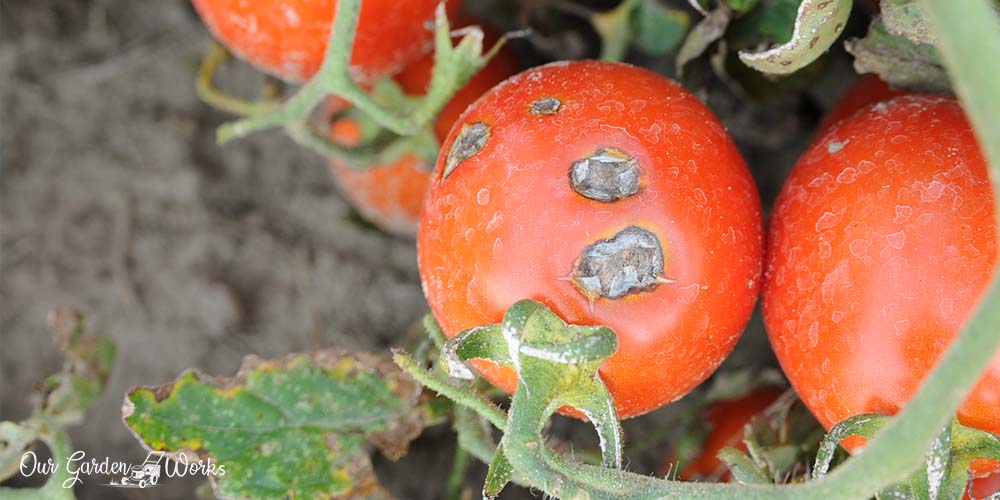










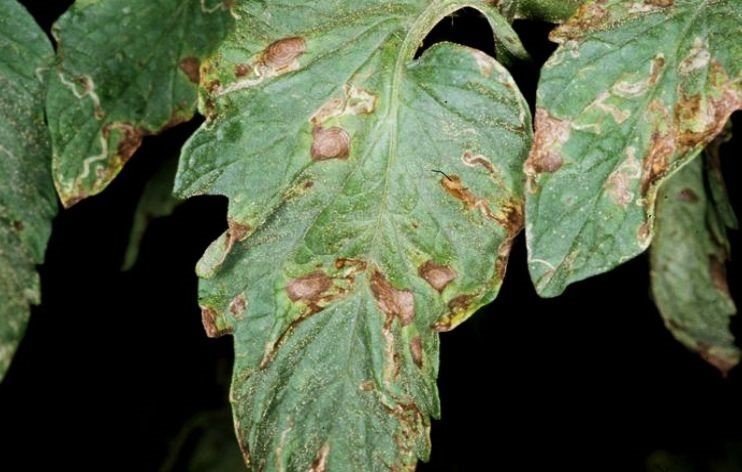
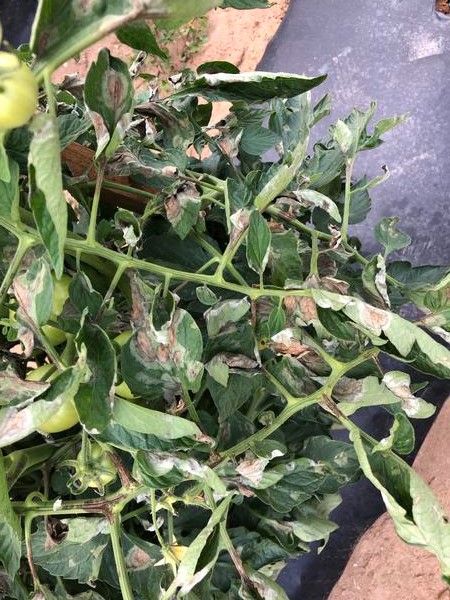
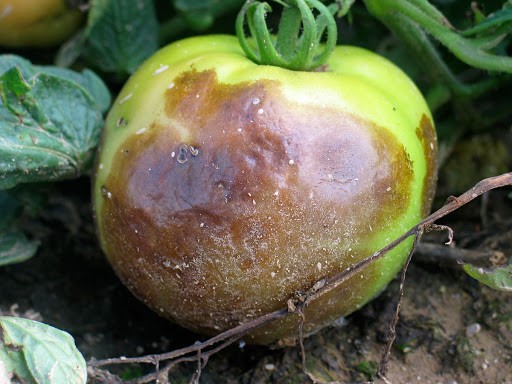
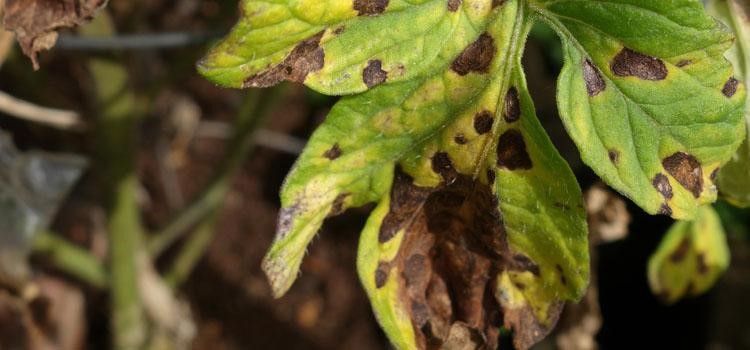
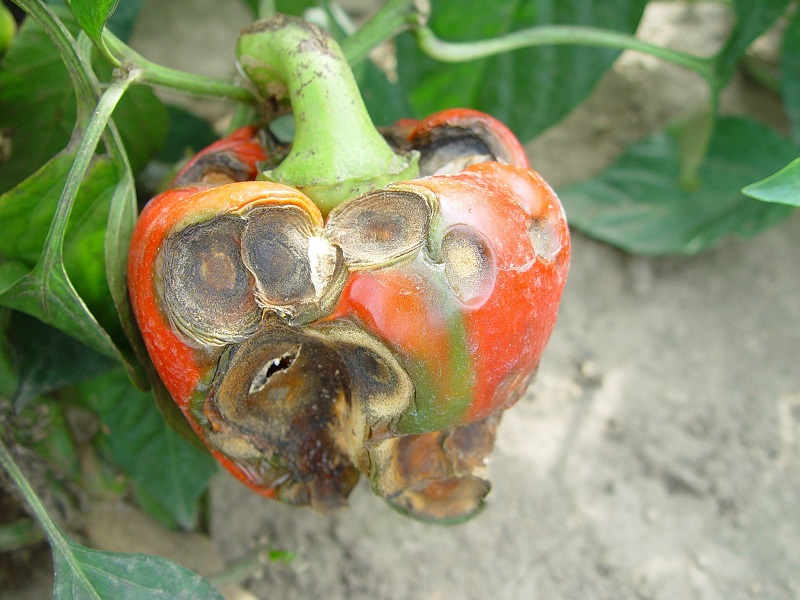
Nice program
This was the most helpful, complete information I have found on keeping tomatoes healthy! Thank you so much for this material. It is much appreciated!
Thank you Wanda! Hope this helps!
Yes Sir!!
Very helpful matter…
Thanks, Rajendra!
Excellent one. Highly educating. Thank you
Why would you include the Serenade product? They stopped making this in 2018!
Infact l like this article because it has really educates me on how to get a good harvest on tomatoes. Thanks